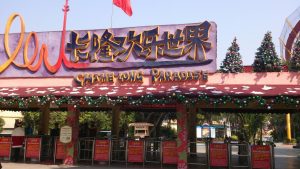 ChimeLong Tourist Resort is located in Panyu, Guangzhou. Known as “China’s most international wildlife park”, it is the largest wildlife theme park in the world with the most species. It is an awesome scenic spot that attracts so many people having travel there. There are many kinds of animals, there are many shows, and you can play for a day there. It’s quite good.
ChimeLong Tourist Resort is located in Panyu, Guangzhou. Known as “China’s most international wildlife park”, it is the largest wildlife theme park in the world with the most species. It is an awesome scenic spot that attracts so many people having travel there. There are many kinds of animals, there are many shows, and you can play for a day there. It’s quite good.
It’s not very far from the subway station. You can take the line 3 and get off at Hanxi ChimeLong Station, and there is an indication to follow after you get out of the subway to arrive at the South Gate. The South Gate also has a convenient place to collect tickets. It’s not too far to go from the south gate to the vertical roller coaster project, which is very exciting and worth your experience. The performances of the various theaters are very exciting. In general, it’s a happy tour to the ChimeLong Tourist Resort.
The Chimelong Happy World is worth a visit. There are more than 20 game facilities in the park, which is suitable for traveling with family, to make the holidays relaxing. This is a good place to have fun. However, the queue time is also about an hour, so don’t remember to take a charging treasure for your mobile phone. Of course, the result of waiting will not disappoint you, and just bring your screams to ChimeLong!
The ChimeLong Wildlife Park is very famous. You will meet many animals that have never been seen before. The environment is enjoyable, the scenery is pleasant, the animals are cute, and the service of the staff is very good.
There are hotels, wildlife world, water world, happy world, crocodile park, and large circus. It is a very well-planned resort. It can basically be played for 2 days. The water world is only suitable for summer play. The ChimeLong construction plan is very considerable and very distinctive.
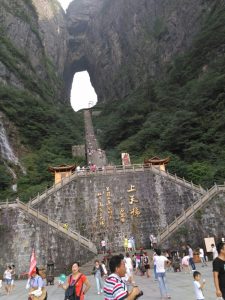 There are three lines in Tianmen Mountain: 1, go up the mountain by taking the car and go down the mountain by taking the cableway; 2, go up the mountain by taking the cableway and go down the mountain by taking the car; 3, both going up and down the mountain by taking the car. And it is highly recommended you to take the route 1, take the cableway to go up the mountain top, then take the escalator to the Tianmen Cave, then you can take the escalator or walk 999 Step stairs down the mountain, then take the car down the mountain. Taking the car up the mountain to climb up will be very tired.
There are three lines in Tianmen Mountain: 1, go up the mountain by taking the car and go down the mountain by taking the cableway; 2, go up the mountain by taking the cableway and go down the mountain by taking the car; 3, both going up and down the mountain by taking the car. And it is highly recommended you to take the route 1, take the cableway to go up the mountain top, then take the escalator to the Tianmen Cave, then you can take the escalator or walk 999 Step stairs down the mountain, then take the car down the mountain. Taking the car up the mountain to climb up will be very tired. After going down the mountain, you can take a long-distance bus to Zhangjiajie Forest Park. In short, Tianmen Mountain is a popular attraction, and you must avoid the time when the travel team goes up and down the mountain. It will save time if you go early and leave early.
After going down the mountain, you can take a long-distance bus to Zhangjiajie Forest Park. In short, Tianmen Mountain is a popular attraction, and you must avoid the time when the travel team goes up and down the mountain. It will save time if you go early and leave early.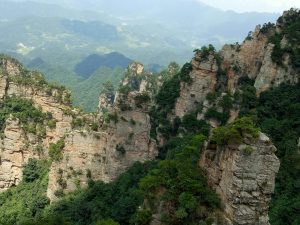 Zhangjiajie National Forest Park is a large forest park with beautiful scenery, high mountains and steep peaks. Although the road signs are somewhat unclear, there are many volunteers and staff to help explain the situation. The toilets in the scenic spots are also clean and tidy. Tickets for the Zhangjiajie National Forest Park are valid for 4 days, and there is plenty of time to play.
Zhangjiajie National Forest Park is a large forest park with beautiful scenery, high mountains and steep peaks. Although the road signs are somewhat unclear, there are many volunteers and staff to help explain the situation. The toilets in the scenic spots are also clean and tidy. Tickets for the Zhangjiajie National Forest Park are valid for 4 days, and there is plenty of time to play.
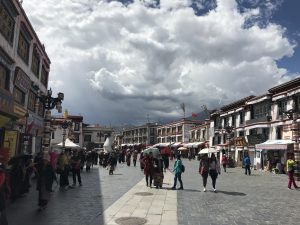 Barkhor Street is the ancient street centered on the Jokhang Temple. The Tibetan people are here to worship Buddha. Most of the streets retain the style of the ancient streets. If you want to know about the traditional Tibetan style, just go to the Barkhor Street. Leaving the main road, all the lanes of Barkhor Street can give you different surprises. You can walk into an old street, and you will find they are all Tibetans chanting. There is no tourist. It is forbidden to take pictures there. It is like the epitome of Lhasa in the past. The only difference is that there are no three lords, no serfs and nobles.
Barkhor Street is the ancient street centered on the Jokhang Temple. The Tibetan people are here to worship Buddha. Most of the streets retain the style of the ancient streets. If you want to know about the traditional Tibetan style, just go to the Barkhor Street. Leaving the main road, all the lanes of Barkhor Street can give you different surprises. You can walk into an old street, and you will find they are all Tibetans chanting. There is no tourist. It is forbidden to take pictures there. It is like the epitome of Lhasa in the past. The only difference is that there are no three lords, no serfs and nobles. Barkhor Street is located in the old city of Lhasa. It is the famous circumanbulation and commercial center of Lhasa, which preserves the traditional appearance and living style of the ancient city. The original street of Barkhor Street is just a single circumanbulation around the Jokhang Temple. The Tibetans call it the “Holy Road”. If you are to visit Lhasa, you can take your trip to the Barkhor Street.
Barkhor Street is located in the old city of Lhasa. It is the famous circumanbulation and commercial center of Lhasa, which preserves the traditional appearance and living style of the ancient city. The original street of Barkhor Street is just a single circumanbulation around the Jokhang Temple. The Tibetans call it the “Holy Road”. If you are to visit Lhasa, you can take your trip to the Barkhor Street.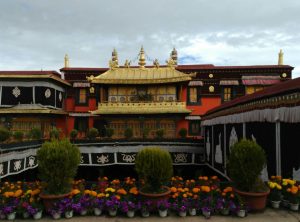 Jokhang Temple is the landmark building in the center of Lhasa, you can see the Jokhang Temple Square from the Golden Summit of the Jokhang Temple. On the far right, it is the Potala Palace. The nearby willow tree is the “Princess Willow”. It is said that it was planted by Princess Wencheng. The layout of the Jokhang Temple is different from that of the Buddhist temples of Han Dynasty. The main hall is located on the east side and faces the west side. The main hall is four stories high and has a matching hall on both sides. The layout structure reproduces the ideal mode of the universe in the Mandala city in Buddhism. The halls in the temple mainly include the Sakyamuni Hall, the Tsongkhapa Masters Hall, the Songtsan Gampu Temple, the Bandan Ram Temple (the Dharmapala of Gelugpai God), and the Tibetan King Hall etc. Due to the tourist season, many halls are not open to the public. It is only open to general tourists at 14:00 o’clock in the afternoon. Tickets for Jokhang Temple are 85 yuan. It is recommended to check the introduction of each hall in the Jokhang Temple in advance so that you can gain more.
Jokhang Temple is the landmark building in the center of Lhasa, you can see the Jokhang Temple Square from the Golden Summit of the Jokhang Temple. On the far right, it is the Potala Palace. The nearby willow tree is the “Princess Willow”. It is said that it was planted by Princess Wencheng. The layout of the Jokhang Temple is different from that of the Buddhist temples of Han Dynasty. The main hall is located on the east side and faces the west side. The main hall is four stories high and has a matching hall on both sides. The layout structure reproduces the ideal mode of the universe in the Mandala city in Buddhism. The halls in the temple mainly include the Sakyamuni Hall, the Tsongkhapa Masters Hall, the Songtsan Gampu Temple, the Bandan Ram Temple (the Dharmapala of Gelugpai God), and the Tibetan King Hall etc. Due to the tourist season, many halls are not open to the public. It is only open to general tourists at 14:00 o’clock in the afternoon. Tickets for Jokhang Temple are 85 yuan. It is recommended to check the introduction of each hall in the Jokhang Temple in advance so that you can gain more.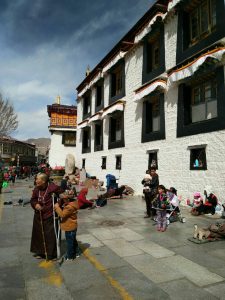
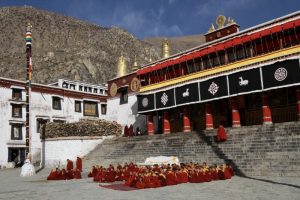 Located in the foothills of the western suburbs of Lhasa, Drepung Monastery is the largest temple in Tibetan Buddhism. The temple’s architectural complex is large in scale, with white houses and red palaces lined up on the mountainside. From afar, it looks like a huge pile of rice. The photos of Drepung Monastery taken on the mountainside are very spectacular. It is the highest-ranking temple in the Gelug Sect of Tibetan Buddhism. The interior architecture is atmospheric and magnificent, which is full of many beautiful treasures, and the Monk’s debate ceremony can be watched there.
Located in the foothills of the western suburbs of Lhasa, Drepung Monastery is the largest temple in Tibetan Buddhism. The temple’s architectural complex is large in scale, with white houses and red palaces lined up on the mountainside. From afar, it looks like a huge pile of rice. The photos of Drepung Monastery taken on the mountainside are very spectacular. It is the highest-ranking temple in the Gelug Sect of Tibetan Buddhism. The interior architecture is atmospheric and magnificent, which is full of many beautiful treasures, and the Monk’s debate ceremony can be watched there.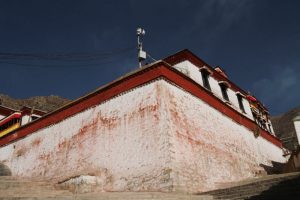
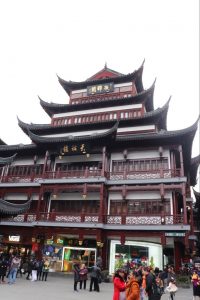 Shanghai Old Street, starts from Henan South Road in the west, to Renmin Road in the east, with a total length of 825 meters. In fact, the old street is next to the business district of Yu Garden. You can go to the old street by visiting the Yu Garden and the Chenghuang Temple.
Shanghai Old Street, starts from Henan South Road in the west, to Renmin Road in the east, with a total length of 825 meters. In fact, the old street is next to the business district of Yu Garden. You can go to the old street by visiting the Yu Garden and the Chenghuang Temple.
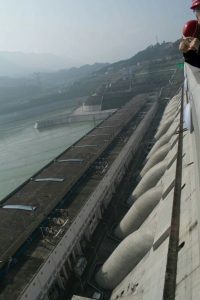 The cruise ship stops at Huangling Temple and then you can visit the Three Gorges Dam, which is the world’s largest hydropower project. To enter the Three Gorges Dam tourist area, you must first go to the tourist transfer center to take the tourist area sightseeing car to enter the Three Gorges Dam tourist area, and people and luggage must undergo strict security checks to ensure the safety of the Three Gorges Dam. The Three Gorges Dam Tourist Area has three sightseeing spots, namely Tanziling, 185 viewing platform and interception memorial garden. Tanziling is the best location for the panoramic view of the Three Gorges Dam. According to the lecturer, the Three Gorges Dam project includes the main building and diversion project, with a total length of 2308m and a dam height of 185m. The total investment of the project is 95.46 billion yuan.
The cruise ship stops at Huangling Temple and then you can visit the Three Gorges Dam, which is the world’s largest hydropower project. To enter the Three Gorges Dam tourist area, you must first go to the tourist transfer center to take the tourist area sightseeing car to enter the Three Gorges Dam tourist area, and people and luggage must undergo strict security checks to ensure the safety of the Three Gorges Dam. The Three Gorges Dam Tourist Area has three sightseeing spots, namely Tanziling, 185 viewing platform and interception memorial garden. Tanziling is the best location for the panoramic view of the Three Gorges Dam. According to the lecturer, the Three Gorges Dam project includes the main building and diversion project, with a total length of 2308m and a dam height of 185m. The total investment of the project is 95.46 billion yuan.
 Shibaozhai is located on the north bank of the Yangtze River in Zhongxian County, Chongqing, which is 45 kilometers from Zhongxian County. Therefore, there is a huge stone of more than ten feet high near the River. According to legend, the colorful stone left by the Nvwa Goddess is called Shibao. Therefore, the stone shape is like a jade, also known as: Yuyin Mountain. In the Ming Dynasty, Tan Hong was uprising. He once occupied the cottage, and Shi Baozhai was named after it. Shibaozhai is built on the Yuyin Mountain, and it stands out from the mountain and has a strange shape. It consists of Zhai gate, Zhai body and attic (Zhaiding Shic ha).
Shibaozhai is located on the north bank of the Yangtze River in Zhongxian County, Chongqing, which is 45 kilometers from Zhongxian County. Therefore, there is a huge stone of more than ten feet high near the River. According to legend, the colorful stone left by the Nvwa Goddess is called Shibao. Therefore, the stone shape is like a jade, also known as: Yuyin Mountain. In the Ming Dynasty, Tan Hong was uprising. He once occupied the cottage, and Shi Baozhai was named after it. Shibaozhai is built on the Yuyin Mountain, and it stands out from the mountain and has a strange shape. It consists of Zhai gate, Zhai body and attic (Zhaiding Shic ha).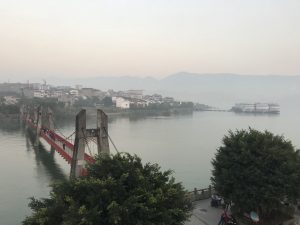 Transportation to the Shibaozhai: In Chongqing Chaotianmen Traffic Square Bus Station you can take a long-distance bus or take a speedboat at Chaotianmen Wharf for 4 hours to reach Zhongxian County, and at Zhongxian Bus Station, transfer to the bus to Shibaozhai.
Transportation to the Shibaozhai: In Chongqing Chaotianmen Traffic Square Bus Station you can take a long-distance bus or take a speedboat at Chaotianmen Wharf for 4 hours to reach Zhongxian County, and at Zhongxian Bus Station, transfer to the bus to Shibaozhai.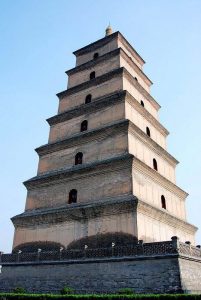 Big Wild Goose Pagoda is located in the southern Cixi Temple in the city. Dacien Temple is the most magnificent royal temple in Chang’an City in the Tang Dynasty. It was built in the Taizong Period of the Tang Dynasty. It was built by the Prince Li Zhi in order to remember his mother, and was hosted by Xuan Zang as the “first presiding”. During the period, the Master supervised the construction of the Big Wild Goose Pagoda.
Big Wild Goose Pagoda is located in the southern Cixi Temple in the city. Dacien Temple is the most magnificent royal temple in Chang’an City in the Tang Dynasty. It was built in the Taizong Period of the Tang Dynasty. It was built by the Prince Li Zhi in order to remember his mother, and was hosted by Xuan Zang as the “first presiding”. During the period, the Master supervised the construction of the Big Wild Goose Pagoda.